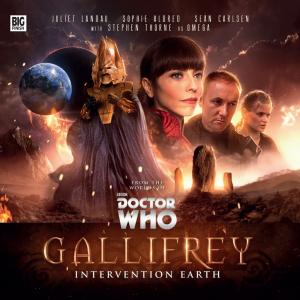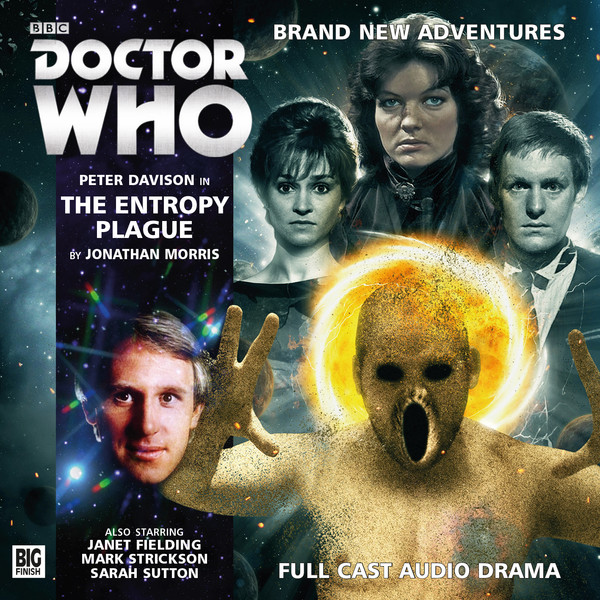
Written by Scott Handcock & David Llewellyn
Produced and directed by Scott Handcock
Big Finish Productions, 2015
“Tell me Lukas, what do you know about the Adherents of Ohm?”
President Romana, Gallifrey: Intervention Earth
Gallifrey was originally conceived by long-time Big Finish and Doctor Who alumnus Gary Russell as BF’s answer to The West Wing, combining the power plays and politicking of Gallifrey’s inner halls of power with extraterrestrial and temporal threats from beyond the Time Lord capital. The mainstays of the series – Romana, Leela and Co-ordinator Narvin (Seán Carlsen), head of the Celestial Intervention Agency (CIA) – began as bitter rivals before remarkably becoming close allies.
Unlike its parent program Doctor Who, Gallifrey’s first 24 chapters across six series were generally complete stories of roughly one hour’s duration each, with numerous story arcs flowing over into subsequent episodes, and for the most part set on Gallifrey (or in later boxsets, variations of the Time Lords’ home world).
The latest instalment of Gallifrey is a departure from the norm in several ways. Intervention Earth is a single story which eschews the one-hour format for a structure more like a classic Doctor Who four-parter (each episode of 30 minutes duration). The overall serial is also intended to be broader and faster-paced, focusing on a conspiracy that is not only confined to Gallifrey but which (as the title obviously implies) encompasses Earth as well. Indeed producer, director and writer Scott Handcock in early publicity for this title described it as “Time Lords meets 24”, an evolution on the Time Lords/West Wing analogy, although that is really an exaggeration. The pace of this serial is very, very different from the urgency and tension of 24. In fact, it strays little from Russell’s original concept.
Of the veterans of earlier series, only Carlsen reprises the role of Narvin. President Romana is also back but in this story the role is not portrayed by veteran Lalla Ward. Instead, the honour falls to former Buffy the Vampire Slayer alumnus Juliet Landau, who portrayed the Time Lady’s third incarnation in Gallifrey VI as well as the Doctor Who Companion Chronicle Luna Romana. Landau portrays a regenerated Romana sometime after the events of Gallifrey VI, when she is in the last term of her presidency. Leela’s role in this drama is ably filled by the Seventh Doctor’s long-running companion Ace (Sophie Aldred). Now a CIA agent, Ace is equipped with her own TARDIS (with functioning chameleon circuit!) but her bolshiness has definitely not been tempered by life and education on the Time Lord home world.
It is hard to judge exactly how good this new “team” is to the “trio” of Gallifrey’s first six series. This is mainly because they are split up across the four episodes and do not unite until the climactic episode. Indeed, each of the four episodes focuses on key characters. Ace is primarily the focus of part one as she is reluctantly paired with Rexx (Gyles Brandreth), an agent of the Time Lord High Council, on a mission to Earth (“Oh no, no, no, I don’t do companions!” Ace protests, much to the listener’s amusement). In part two, the limelight is shifted to Romana’s presidential aide Lukas (Scott Arthur) as he uncovers an age-old conspiracy on Gallifrey (long-time listeners of the Gallifrey saga will recognise that Arthur played an alternate version of Lukas in Gallifrey V and VI). Part three sees Narvin journey to Stone Age Earth to recover Ace and uncover a cult with links to the conspiracy occurring on Gallifrey. In the process, Narvin becomes aligned with huntress Sol (Rachel Atkins) and boatman Min (Toby Longworth). Considering he ought to have gained a better understanding of primitives from his adventures with Leela, it is amusing to hear that Narvin is equally out of his depth with Sol and Min!
The gang comes together in the last episode as Romana takes charge and she and Lukas are reunited with Narvin and Ace in a confrontation with an ancient Time Lord foe whose machinations threaten the universe itself. Until this point, Juliet Landau’s portrayal of Romana is rather dull and underwhelming, restricted to the character’s presidential duties and diplomacy. Indeed, whether it is down simply to Handcock and Llewellyn’s dialogue or simply that this version of Romana is meant to be more cautious than her previous selves, Landau’s performance is at times almost monotonous. There is certainly none of the humour and mischief that she exhibited as Romana III in banter with Romana II in Gallifrey VI or indeed the naivety and haughtiness she displayed in relating Romana I’s story in Luna Romana. It is a surprisingly flat portrayal. It is only when faced with the serial’s antagonist that President Romana (and Landau herself) really rises to the moment.
If you’re still uncertain who or what the menace of Intervention Earth is, then read no further. However, if you’ve spied the cover artwork for the release, then the helmeted figure in chainmail armour and flowing robes will be unmistakably familiar to 99.9 per cent of long-time Doctor Who fans and BF listeners. The villainous Time Lord pioneer Omega only made two appearances in Doctor Who on television but left an indelible mark on the mythology of the TV series. From the picture book K9 and the Time Trap in 1980 (which called him Omegon!) to children’s and adult novels (Search for the Doctor, The Infinity Doctors), and from comic strips to Big Finish’s own audio range, which released the self-titled Omega in 2003, the character’s life outside the TV series is as seemingly infinite as his ego. Despite the masterstroke casting of the original actor Stephen Thorne (who is himself a Doctor Who monster alumnus, dating back to 1971), Omega’s involvement in this story is less overt than expected. Considering what a magnificent voice Thorne has for Omega (his commanding voice reminds you why in The Three Doctors it was so pivotal to an entity whose will was all that remained of his being), it is disappointing that his encore performance is so limited and wasted. However, as you discover in the closing moments of the serial, Omega’s role in the plot has been subtly and cleverly all-pervading – and we haven’t seen the last of him ... Whether we will hear Thorne’s booming and authoritative tones again, though ... I guess watch BF’s space. At the very least, Thorne deserves another opportunity to shine.
The conclusion to Intervention Earth is open-ended and the listener is literally left hanging. With the serial’s chief antagonist on the loose, the serial ends on another twist, as another familiar figure (missing since the events of Gallifrey IV) makes a surprise entrance. Whether this figure’s return is a blessing or a curse remains to be seen. What is also not equally clear is whether the next instalment – Gallifrey: Enemy Lines – will address some of the ramifications of Intervention Earth. With further details scarce at the time of writing, Enemy Lines appears to predate Intervention Earth, as Lalla Ward and Louise Jameson will reprise their roles as Romana II and Leela, supported by Narvin and Ace. Of course, perhaps there may be a link – or the cliffhanger to Intervention Earth will be resolved in an entirely different serial at a later date.
That said, perhaps Enemy Lines will address some of the other hints that are dropped in Intervention Earth about both Leela and Ace. Dialogue in the serial implies that Romana and Leela will have a falling out while Ace remarks that she cannot remember any more how, when and why she came to Gallifrey. While various other BF Doctor Who audios (such as Thin Ice) and the New Adventure novel Lungbarrow have previously provided explanations of how and why Ace may have settled on Gallifrey, perhaps there is a fertile plotline here for future chapters of the saga. Ace certainly proves to be susceptible in Intervention Earth ...
If you overlook Handcock’s imprecise comparison to 24, Gallifrey: Intervention Earth maintains the high production values, artiste performances and scripting of its predecessors in the Gallifrey series. While the “regenerated” format and structure are hardly revolutionary, and the decision to set the story later in Romana’s life and presidency is not as intriguing or refreshing as it initially seemed in all the pre-release publicity, there are still signs that the Gallifrey saga is heading in the right direction and that there may still be some interesting twists in future releases.







